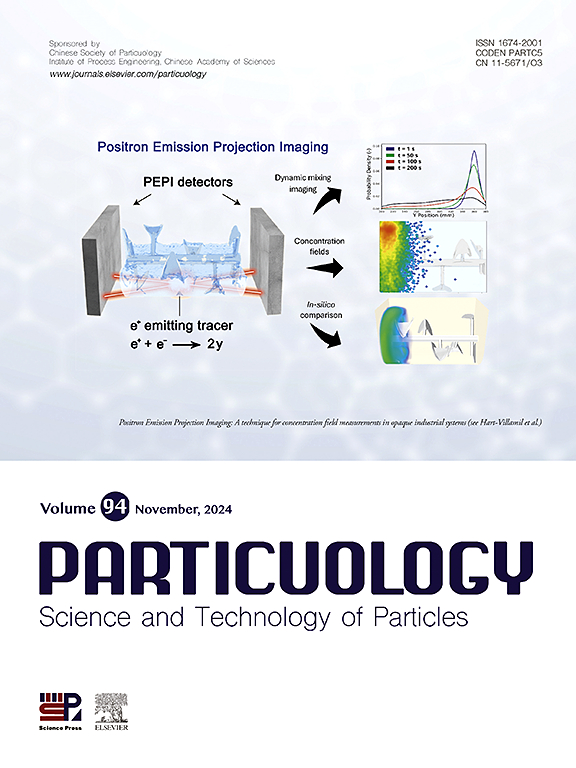复合粒子的结构、自由表面能参数和直接压实性能:表征和相关分析
IF 4.3
2区 材料科学
Q2 ENGINEERING, CHEMICAL
引用次数: 0
摘要
本研究旨在比较分析不同改性剂对共喷雾干燥制备的复合颗粒(CPs)的结构、自由表面能参数和直接压实性能的影响,探讨CPs的结构、自由表面能参数和直接压实性能之间的相关性。通过添加不同的改性剂,制备了葛根石蜡。对CPs的结构、自由表面能参数和直接压实性能进行了表征。利用Pearson相关分析和人工神经网络方法评价了cp的结构、自由表面能参数和直接压实性能之间的相关性。结果表明,不同的改性剂对CPs的结构、自由表面能参数和直接压实性能的影响是不同的。Pearson相关分析显示,粒径分布、均匀度、亮度与极性组分、极性指数呈正相关,差异均有统计学意义(P <;0.01)。极性组分和极性指数与流动性、崩解时间呈正相关,与致密性呈负相关,差异均有统计学意义(P <;0.01)。总的来说,这些发现有助于更好地建立CPs的结构、自由表面能参数和直接压实性能之间的理论模型,为预测材料性能提供理论依据。本文章由计算机程序翻译,如有差异,请以英文原文为准。

Structure, free surface energy parameters, and direct compaction properties of composite particles: Characterization and correlation analysis
This study aimed to compare and analyze the effects of different modifiers on the structure, free surface energy parameters, and direct compaction properties of composite particles (CPs) prepared by co-spray drying and to explore the correlation among structure, free surface energy parameters, and direct compaction properties of CPs. CPs with Puerariae lobatae radix were prepared by adding different modifiers. The structure, free surface energy parameters, and direct compaction properties of CPs were characterized. Furthermore, Pearson correlation analysis and artificial neural network methods were used to evaluate the correlation among structure, free surface energy parameters, and direct compaction properties of CPs. The results showed that different modifiers exhibited variegated effects on the structure, free surface energy parameters, and direct compaction properties of CPs. Pearson correlation analysis showed that the particle size distribution, uniformity, and brightness were positively correlated with polar components and polarity index, with statistical significance (P < 0.01). The polar components and polarity index were positively correlated with flowability and disintegration time, and negatively correlated with compactibility, with statistical significance (P < 0.01). Overall, these findings contribute to better establishing a theoretical model among structure, free surface energy parameters, and direct compaction properties of CPs and provide a theoretical basis for predicting material properties.
求助全文
通过发布文献求助,成功后即可免费获取论文全文。
去求助
来源期刊

Particuology
工程技术-材料科学:综合
CiteScore
6.70
自引率
2.90%
发文量
1730
审稿时长
32 days
期刊介绍:
The word ‘particuology’ was coined to parallel the discipline for the science and technology of particles.
Particuology is an interdisciplinary journal that publishes frontier research articles and critical reviews on the discovery, formulation and engineering of particulate materials, processes and systems. It especially welcomes contributions utilising advanced theoretical, modelling and measurement methods to enable the discovery and creation of new particulate materials, and the manufacturing of functional particulate-based products, such as sensors.
Papers are handled by Thematic Editors who oversee contributions from specific subject fields. These fields are classified into: Particle Synthesis and Modification; Particle Characterization and Measurement; Granular Systems and Bulk Solids Technology; Fluidization and Particle-Fluid Systems; Aerosols; and Applications of Particle Technology.
Key topics concerning the creation and processing of particulates include:
-Modelling and simulation of particle formation, collective behaviour of particles and systems for particle production over a broad spectrum of length scales
-Mining of experimental data for particle synthesis and surface properties to facilitate the creation of new materials and processes
-Particle design and preparation including controlled response and sensing functionalities in formation, delivery systems and biological systems, etc.
-Experimental and computational methods for visualization and analysis of particulate system.
These topics are broadly relevant to the production of materials, pharmaceuticals and food, and to the conversion of energy resources to fuels and protection of the environment.
 求助内容:
求助内容: 应助结果提醒方式:
应助结果提醒方式:


